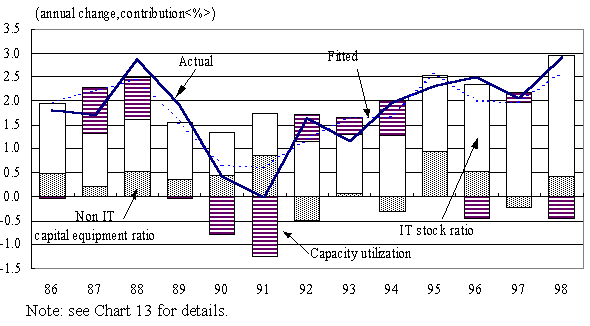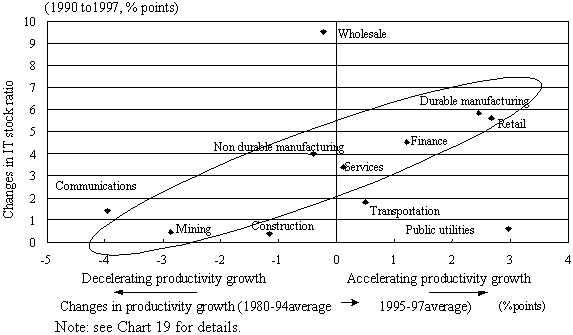June 2000
Yoshihito SAITO
Papers in the International Department Working Paper Series are circulated in order to stimulate discussion and comments. Views expressed are those of authors and do not necessarily reflect those of Bank of Japan or the International Department.
If you have any comment or question on the working paper series, please contact each author whose e-mail address is shown in the columns next to each title.
Click on iwp00e01.pdf (249KB) to download the full text.
Summary
- The US economy has been booming for almost nine consecutive years after hitting bottom in March 1991. It is often said that this long period of economic expansion is due to the enhanced productivity of the overall US economy through the active use of computers and the Internet to realize labor saving, inventory reductions, and sales network expansion. However, labor productivity, which is obtained by dividing real GDP by labor input, grew only about 1.5% on average annually until the mid-1990s. Thus, it has been argued that the quantitative contribution of information technology (IT) investment to economic growth by reinforcing the supply side of the economy cannot be confirmed ( which has been called the "IT Paradox").
- However, data since 1996 shows that labor productivity growth has risen to an average 2.5% annually. This is partly due to the comprehensive revision of GDP statistics released on October 1999, whereby software expenses are now recorded as value added. This pushed up GDP figures, since the growth in IT investment is directly reflected in GDP growth. However, even excluding the upward effect occasioned by the comprehensive revision of GDP statistics, labor productivity improvement became prominent in the latter half of the 1990s.
- This paper examines some factors that have been contributing to the recent improvement in productivity, among which IT investment is our major interest. First, by decomposing real GDP into several factors, we verify that technological innovation actually contributes significantly to economic growth. It is found that capital stock and labor input are not enough to fully explain enhanced real GDP growth in the 1990s. Rather, factors other than the above, namely "Total Factor Productivity", have been found to account for roughly half of economic growth in the latter half of the 1990s. It is also thought that the effect of the substitution of capital stock for labor input is not a major cause of the increase in labor productivity, because the capital equipment ratio did not rise to any significant degree.
From this analysis, it becomes apparent that "technological innovations" that enhances output per unit of capital equipment and per unit of labor became increasingly conspicuous during the late 1990s, consequently contributing considerably to real GDP growth.
- It has been confirmed that the recent increase in labor productivity led by technological innovation is mainly because of IT investments. It is estimated that about 80% of the increase in labor productivity since 1995 has been induced by the increase in the ratio of IT stock to the total capital stock.
Regression of Labor Productivity (all industries)

- The fact that active IT investment has led to an increase in productivity partly reflects the improved efficiency of computers and networks. More importantly, synergies emanating from IT stock have increased the productivity of other capital stock and labor, which eventually lead to technological innovation.
To verify this point, the relationship between IT stock and productivity was analyzed using productivity data for various industries. The following became apparent as a result:
- a) In the retail, durable goods manufacturing (especially industrial machinery and electronic machinery), and financial industries, both the ratio of IT stock to non-IT stock and growth rate of labor productivity accelerated in the late 1990s. It can be said that (1) these industries have benefited from the fruit of IT innovation and (2) competition with foreign companies has been intense and a reduction in labor costs has been indispensable.
- b) In the service sector, labor productivity is relatively low due to its labor-intensive nature. However, in some industries like business services, productivity improvements occasioned by aggressive IT investment stand out.
Correlation between IT stock and Labor Productivity (all industries)

- c) Labor saving was the original aim of IT investment. However, it is noteworthy that the productivity gains have generated new business opportunities, expanding US employment significantly in the retail and service areas since the mid-1990s. This expansion took place supported by an entrepreneurial friendly environment and a highly flexible labor market. Another notable change during this period is the increasing proportion of highly skilled jobs stemming from accelerated IT investment.
- Most US companies are expected to continue IT investment. This is due to the decline in price of IT goods in comparison with employment cost and increased competition with foreign economies. Yet, a higher proportion of low skilled workers in some industries such as construction and the possibility of a shortage in the supply of skilled labor in the economy may be potential obstacles to a further increase in IT investment.
- In the process of improving labor productivity after recovering from the recession in the early 1990s, the US economy has benefited from IT innovation. The background to this success is as follow
- a) The penetration of corporate governance that ceaselessly demanded the accurate evaluation of risk and return for each business.
- b) The increased competitiveness of financial and capital markets, which enabled the efficient supply of risk capital.
- c) Extensive restructuring and reengineering of business processes that enable the efficient use of limited capital and human resources.
The experience of the US, where productivity of the overall economy was enhanced through eliminating structural problems while expanding IT investment, is a meaningful lesson for Japan and European countries.
Key terms:
Productivity, Information Technology, IT paradox
JEL classification:
D20, L10, N10, O30, O40


